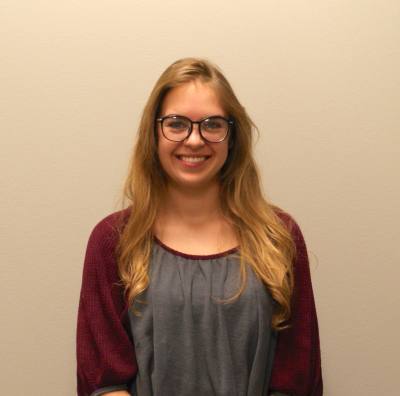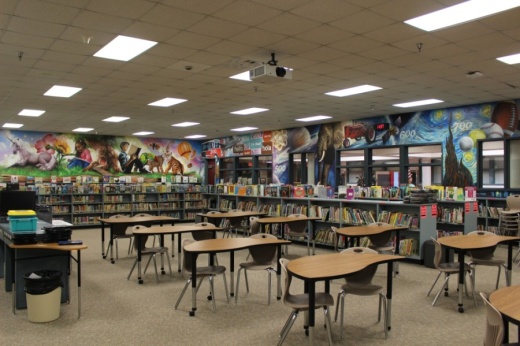The present school, which was built in 1965 and renovated most recently in 1995 to accommodate Katy’s growing population, sits on the same site and is still attended by descendants of some of the original settlers to the Katy area.
While the decades of life have earned Katy Elementary a historic landmark designation, the years also have brought on challenges as the campus has aged. Lack of storage and classroom space, temperature issues and dated infrastructure are just a few obstacles facing staff, Katy Elementary librarian Andrea Taylor said.
“One room will be ice cold, and another is way too hot,” Taylor said. “And everywhere, really, there’s just not enough space.”
Because there are so few options for storage, an old telephone booth has become a landing spot for school records. A crowded room once used as a locker room by the school gym—which also is not up to regulation size—is now used for storage and even as a testing room for students. The school’s “new wing is about 25 years old.”
Despite the challenges, the school is beloved, Principal Beth Grimet said. But for teachers to provide the top-quality education they strive to offer, the school needs upgrades, she said.
“We need some retrofits done—and I don’t just mean with technology,” Grimet said. “I mean some renovations, because times have changed in education, and we want to address those needs.”
Nearly $22.9 million to fund renovations, upgrades and additions for the school could be on the horizon if KISD voters support a four-proposition bond package during the upcoming May 1 election.
In total, the $676.23 million bond package voters will find on the ballot would fund more than 400 projects across the district, including the construction of five new schools, major renovations for aging campuses, safety improvements and technology upgrades for schools.
“We love our school and want to keep its history, but we, like other schools, need repairs,” Grimet said.
Bond projects
The KISD board of trustees called for the bond election at a special meeting Feb. 8 after hearing a recommendation from a bond advisory committee.
The committee, which was was made up of more than 100 parents, students and KISD community members, was organized to discuss the rapid student growth and whether a bond election should be called in May.
Committee members in late January voted almost unanimously to recommend the bond package to the district’s board of trustees.
Proposition A, which makes up the majority of the bond package cost at about $591.37 million, would fund new schools, the purchase of school sites, renovations and expansions for aging campuses such as Katy Elementary, and safety and security updates.
The district would use some of the funds to build three elementary schools, one junior high school and one high school. Additionally, funds from Proposition A also would pay for portable buildings, buses, furniture and equipment. With a cost at $59.76 million, Proposition B is focused on classroom and campus technology. The proposition would provide the district money for wireless upgrades, cybersecurity infrastructure, classroom student devices and teacher instructional laptops.
The need for significant technology updates became even more apparent during the pandemic, as both teachers and students had to quickly adapt to remote school, district staff said.
Proposition C, which has a price tag of about $13.84 million, would fund a natatorium for the new high school slated to be built as part of Proposition A. All of the district’s other high schools have natatoriums, so staff wanted to ensure that the newest high school does as well.
Finally, Proposition D, at a total of about $11.26 million, would pay for needed campus and district athletic facility and stadium repairs. Projects would include replacing gym bleachers, track surfaces and field lighting.
Board member Dawn Champagne said at the Feb. 8 meeting she was impressed with the time and effort both the bond advisory committee and district staff had put into preparing the bond package and was looking forward to the election.
“I’m anxious to see this going forward for a vote,” she said.
District growth
KISD Superintendent Ken Gregorski said at the Feb. 8 board meeting that the board’s support of the bond package was not a surprise. At the rate the district is growing, he said, it is vital the district prepare for the future.
KISD is projected to hit 100,000 students by 2027, according to a study done by demographics firm Population and Survey Analysts. That figure confirms KISD to be the fastest-growing large school district in the state, according to the district.
If KISD voters do not support the bond package, Gregorski said, the district will quickly find itself facing challenges with overcrowding. For example, in 2025, he said, there would likely be approximately 5,000 students at Paetow High School and 4,000 at Katy High School, which is far beyond the capacity for both, since the high schools are built to hold 3,000 students each.
“[This bond package] is what we need to get us to about 2025 to keep up with the growth,” Gregorski said.
KISD Chief Financial Officer Christopher Smith said when using conservative tax base growth and interest rate assumptions, the district has the capacity to authorize $700 million in bonds in 2021 and $800 million in bonds in 2024—while maintaining the current interest and sinking tax rate of $0.39 per $100 of assessed valuation.
Given the student growth projections, Smith said May was an opportune time to move forward with a bond package that would also take advantage of low interest rates.
“They’re coming,” Smith said. “And we got to have a place to put those children. They might not even know they’re coming yet, but they’re coming.”
KISD, like districts across the nation, has grappled with the financial uncertainty brought about by the coronavirus pandemic over the past year, Gregorski said. Still, the district must move forward as the community continues to recover.
“What do we do?” he asked. “Do we sit back and not do a bond because of the economy where it is, when we know it’s going to get better in the next year or two years, three years as we start to build the economy back? I think the better thing is to now plan for that future, rather than sit back and not have a plan.”
May election
The Texas Legislature has required school bond ballots to include a statement declaring the bond election “is a property tax increase.” KISD officials, however, have emphasized the interest and sinking tax rate will not increase if the bond package is passed, but will remain $0.39 per $100 valuation.
“The last thing I want is for our voters to think we weren’t being genuine with that message,” Gregorski said.
Although the tax rate would not increase, the length of time the community pays for KISD’s existing and new debt would be extended because the outstanding debt total would increase. Currently, the district is projected to pay off all debt by 2051. If voters pass the bond package in May, that would be extended to 2055.
However, those figures can change, said Maria DiPetta, KISD’s media relations and multimedia manager. KISD has made it a goal to maintain the $0.39 interest and sinking tax rate, and if it does maintain that rate going forward, the debt would be paid off sooner than projected and fund future bonds.
The Texas Legislature also mandated that bond packages be broken up into separate propositions, Gregorski said, which is why voters will see four propositions on the ballot. The move helps districts demonstrate transparency to voters, Gregorski said. Technically, voters could pass just one or several of the propositions and not all four.
Ultimately, Gregorski said, the district wants to encourage voters to do their research in the weeks ahead of the election and exercise their right to vote when election day comes along.
Grimet, too, said while she hopes residents will vote in favor of the bond package to fund necessary improvements for Katy Elementary and schools districtwide, she hopes residents take the time to become informed before heading to the polls.
“You need to express your opinion, whatever that opinion is,” she said. “That’s going to help grow our community.”





